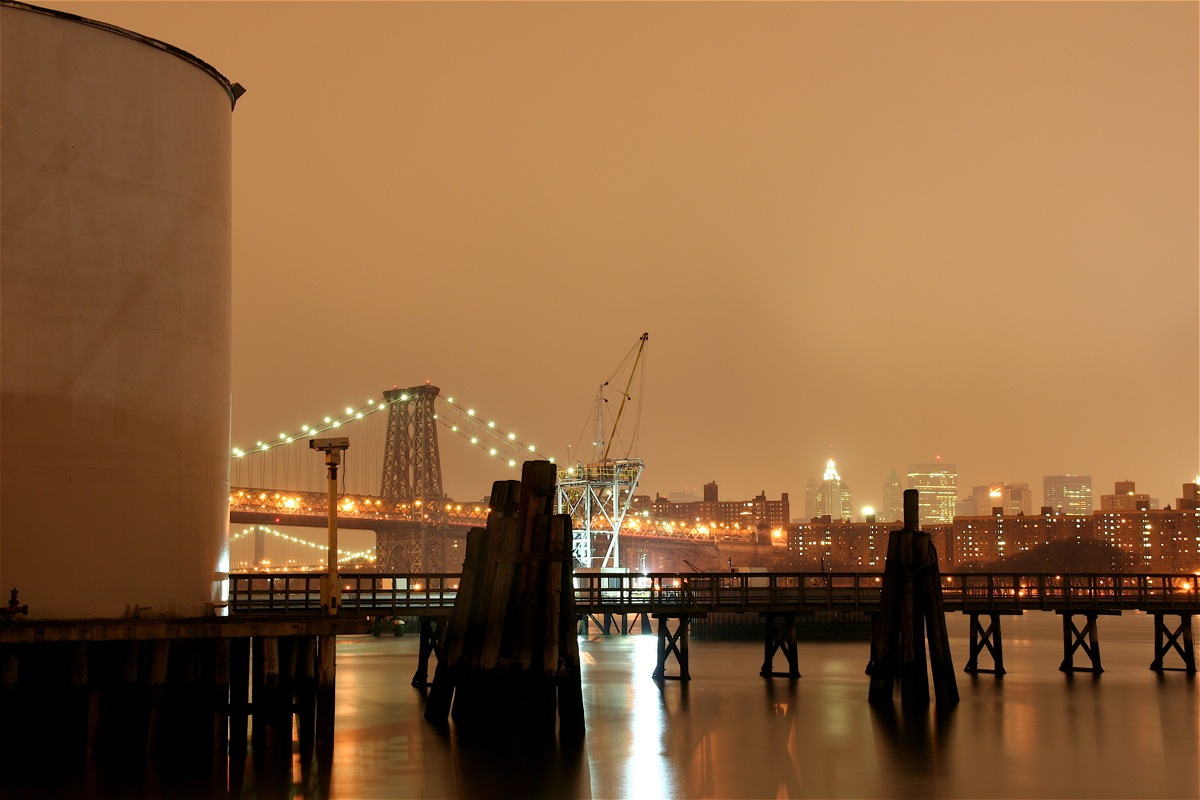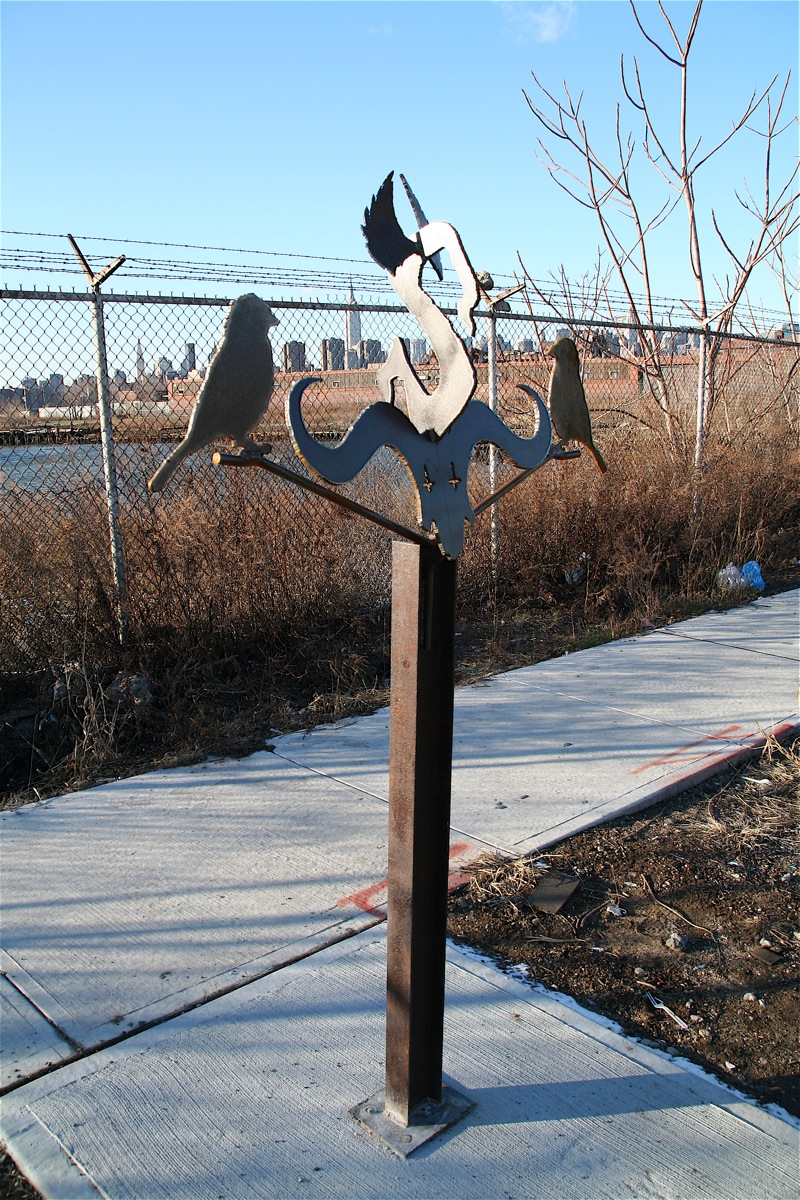A Walk Around Greenpoint, Part Three: Stinky, Yet Beautiful

Over the past couple of years, we've witnessed a strange, alienesque complex of giant onion-shaped structures rising over the banks of Newtown Creek on the northernmost edge of Greenpoint. If you've been anywhere in Greenpoint, Long Island City, or driven on the western end of the Long Island Expressway, you've probably seen them, too.
Greenpoint residents (and curious-types like us) already know that the huge pods are a new part of the Department of Environmental Protection's (DEP) Newtown Creek Water Pollution Control Plant (WPCP). The Newtown Creek plant - the largest of New York City's 14 WPCPs - also happens to be the only remaining plant that's incapable of "secondary" treatment of wastewater.
The DEP's website provides this primer for the poor souls who missed sewage treatment class:
Preliminary Treatment: The first step in wastewater treatment is preliminary treatment to screen out, grind up, or separate debris. Sticks, rags, large food particles, sand, gravel, toys, etc., are removed at this stage to protect pumping and other equipment in the treatment plant. The collected debris is usually disposed of in a landfill.
Primary Treatment: Refers to the separation of suspended solids and greases from wastewater. Wastewater is held in a quiet tank for several hours allowing the particles to settle to the bottom and the greases to float to the top. The solids drawn off the bottom and skimmed off the top receive further treatment as sludge. The clarified wastewater flows on to the next stage of wastewater treatment.
Secondary Treatment: In place at all WPCPs with the exception of Newtown Creek, this refers to the biological treatment process to remove dissolved organic matter from wastewater. Microorganisms are cultivated and added to the wastewater, digesting organic matter from sewage as their food supply.
Disinfection: Final treatment focuses on removal of disease-causing organisms from wastewater. Treated wastewater can be disinfected by adding chlorine or by exposing it to ultraviolet light.
The treated sludge is dewatered and subsequently used for soil enhancement, while the water fraction is treated and then discharged into harbor waterways.
And so you ask: "But whatever do they do with the sludge from Newtown Creek?"
Well here's where it gets good. The solid part (yep, your poo) gets baked into fertilizer pellets at the New York Organic Fertilizer Company plant in the Bronx. The
The liquid sludge gets loaded onboard one of three DEP "Sludge Boats", and sails down the East River to a WPCP that does do the secondary thing (and presumably has time to do Newtown Creek's dirty work for it).

M/V Newtown Creek
I Sludge New York
In the good ol' days (until the late 1930s), sewage treatment was limited, and the few operating plants just puked the sludge over the railing into the closest waterway. In the early '40s, the Department of Sanitation began restricting the practice, and the city's fleet of sludge boats was born. At first, the ships dumped their goods in the Narrows, between Bay Ridge and Staten Island, soon turning to Long Island Sound for fear of German U-Boats during WWII.
In 1972, new environmental regs pushed the dumping to 12 miles offshore, and in 1987, when the law was amended to force dumping to 106 miles offshore (not in MY reef!), the boats began ferrying the sludge across the harbor to ocean-going barges.
Finally, in 1991, the Ocean Dumping Ban Act outlawed the practice entirely, and the city's remaining fleet of three ships switched to transporting the waste to other WPCPs for secondary treatment. Which brings us back to the giant pods in Greenpoint.
Its About Stinking Time
In August 2003, the Newtown Creek plant began a 10-year, $2.4 billion retrofit and expansion, designed to increase throughput by 50%. The plant currently treats an average of 238 million gallons of water per day (that's almost 87 billion gallons per year; the plant's so large, it treats waste for much of Manhattan as well as huge sections of Brooklyn and Queens). The overhaul also adds secondary treatment capabilities - potentially putting the sludge boats out of business (sludge boat booze cruise, anyone?). And it brings New York City into compliance with the Clean Water Act.
And the Giant Chrome Onions?
Those are eight new "grit, aeration, and separation tanks" (aka "digesters"), being built by Skanska-USA. They each hold 3 million gallons, are 84 feet in diameter, and stand 90 feet tall. They took over 2.1 million cubic yards of concrete to build.
More digester photos [Flickr]
Great upgrade project overview [water-technology.net]
History of the sludge boats and harbor dumping [Clearwaters]
Citizen's Guide to the Sewershed [excellent pdf download that unpacks Newtown Creek's WPCP (4 MB)]
NYCDEP Website










